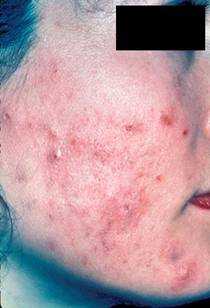Adolescent acne
Early lesions can develop around age 8 to 10 years, with a peak in late adolescence and continuance through the late twenties or early thirties.
Acne vulgaris is classified based on the predominant lesion type as comedonal, papular, pustular, or cystic. Most adolescents will have a mixture of open and closed comedones, red papules, and pustules at the time of examination.
- Open comedones or "blackheads" occur when the sebaceous follicle is obstructed at the follicular mouth, and a wide opening develops which is filled with a plug of stratum corneum cells. The black color results from oxidized melanin within the stratum corneum cellular plug, not dirt.
- Microcomedones or closed comedones or whiteheads result from obstruction of the sebaceous follicle just beneath the follicular opening in the neck of the follicle. This produces a cystic cavity which continually accumulates stratum corneum.
- Inflammatory lesions are red papules, pustules, nodules, cysts and occasionally interconnecting draining sinus tracts. Most adolescents will have a mixture of open and closed comedones, red papules, and pustules at the time of examination.
Adolescents with cystic acne require prompt medical attention because ruptured cysts and sinus tracts result in scar formation. Acne can be exacerbated in adolescents with friction through headbands, football helmets, and tight garments. In addition, oil-based cosmetics and hair sprays may exacerbate comedonal acne.

Adolescent Acne